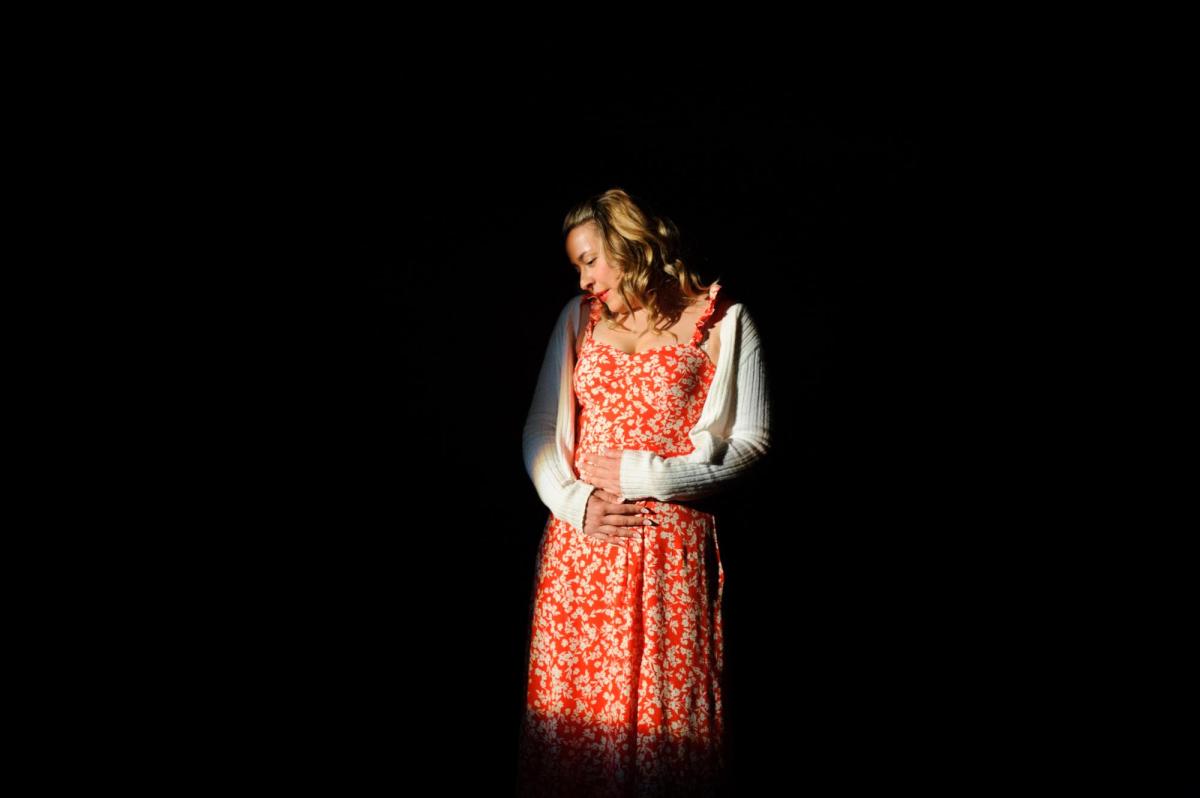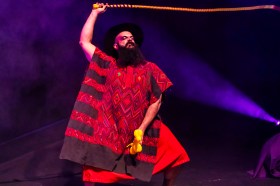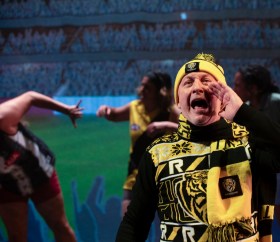Milk and Blood are two works for solo actors, 70-minute monologues performed in sequence, connected very loosely by themes of violence – particularly sexual violence – and written and co-directed by Melbourne-based writer and director Benjamin Nichol.
The first, Milk, introduces us to Mummy – a woman for whom childbearing carries a blissful sense of connection, like she’s doing the thing she was made to do. Mummy has two sons, her clear favourite (despite protests to the contrary) is Boy, her eldest.
The form of a monologue in drama (despite its long history) is a tricky one to carry out successfully – requiring the telling of a story to become active, the writing to reveal, to drop hints and to carry the audience on a journey. For the actor, there is nowhere to hide. Nichols has assembled an excellent team to bring these thoughtfully composed pieces to life, including two experienced and charismatic actors (who also act as co-directors in their own pieces) who have made smart choices in their performances to heighten the dramatic twists and turns of each narrative.
Gallacher as Mummy is Stepford-wife chic. Rosy-cheeked and golden-curled, with a red sundress and white cardigan, she quite literally bounces around the stage. She works in disability, she doesn’t hang out with the bitchy mothers at school pick-up, because she’s nice. So, as the cracks start to reveal something darker going on, as we learn Mummy’s golden child son, Boy, is in prison, as we begin to understand her inability to see the violence of which he was capable – and where that role modelling may have come from – the contrast to her Pleasantville-esque, coiffed presentation of maternal self-satisfaction is stark.
Gallacher captures and conveys the nuances of Mummy, and her performance is compelling. The dive into the psyche of a mother faced with the horrors of her own child’s monstrous acts is a fascinating subject – how to reconcile the child one loves with the deeds? How to not feel the weight of guilt, or a sense of responsibility for their acts, when you are the one who has given birth to them and raised them? We see Gallagher as Mummy, a woman intoxicated with the hormonal oxy cocktail of motherly love, as she confronts the ugly truth about her son, and as she bares and shares the ugliness within.
The second monologue introduces us to Daddy (performed by Charles Purcell), a queer professional BDSM (bondage and discipline, dominance and submission, sadism and masochism) sex worker, paid to dominate his clients. Dressed in gym pants, red trainers and tank top, he flexes, poses and prowls across the stage. He tells us he is proud of his body, and he takes his work seriously. He’s an athletic force of nature who admits early on that he can’t imagine being a sub (because he wouldn’t want to relinquish control); we witness as Daddy becomes victim to an act of homophobic sexual violence that diminishes him physically and psychologically before our eyes. The impact of the trauma on such a powerful figure is shocking.
Both performances are expertly choreographed, the whole stage and depth of space used to maximum dramatic effect and enhanced by the simply brilliant and (seemingly) brilliantly simple lighting design by Harriet Hogan, which (in concert with the carefully controlled sound design by Connor Ross) creates space, place and mood – technical works of art that hide their craft. Smoky haze filling the room allows for the lighting states to create three-dimensional worlds, which as the drama amps up, become fast-paced and frequent, highlighting dramatic beats and building tension.
As two works of theatre, Blood and Milk are both exciting pieces of new writing dealing with the impacts of violence and trauma. As a holistic performance, I’m not convinced there was a good reason to stage both consecutively – each of these works is a stand-alone piece, and the juxtaposition of each, despite the related themes of violence, doesn’t add enough to the overall experience to warrant the choice.
Read: Performance review: Interior by Rawcus, The Substation
While there is so much to love about the writing, it is strongest when it is less self-consciously poetic or narrating of the character’s internal world. Also when it works to enhance the inherent drama of each scene, and the actors are able to shine in bringing out the nuances of the writing in performance – the revelations, the clues that lead to a flash of discovery about each character. The ending of Blood, as Daddy confronts his attacker, could have exercised more restraint in the writing – allowing that moment to hang, for the actor to be given a moment of choice, and for the audience to fill in the gaps.
Milk and Blood
fortyfivedownstairs
Writer and co-Director: Benjamin Nichol
Performer and co-Director (Milk), Dramaturg (Blood): Brigid Gallacher
Performer and co-Director (Blood), Dramaturg (Milk): Charles Purcell
Lighting Designer: Harrie Hogan
Sound Designer: Connor Ross
Additional Dramaturgy: Izabella Yena
Stage Manager: Jacinta Anderson
Milk and Blood will be performed until 1 September 2024.





